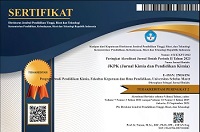Total Synthesis and Molecular Docking study of Peptide AWVDY as an Anti-inflamation Agent
Abstract
Bioactive peptides are known for their diverse biological functions, many of which support health and well-being. In this study, we synthesized and evaluated the anti-inflammatory potential of the peptide AWVDY, derived from oyster (Crassostrea rivularis). The synthesis was performed using the solid-phase peptide synthesis (SPPS) method, applying the Fmoc strategy on 2-chlorotrityl chloride (2-CTC) resin, and achieved a high yield of 95.83%. The resulting peptide was characterized using Time-of-Flight Mass Spectrometry (TOF-MS), which detected a peak at m/z [M+H⁺] 653.1418, consistent with the expected molecular formula C₃₂H₄₀N₆O₉. This was further validated by analytical HPLC, showing a retention time of 22.596 minutes. Molecular docking studies indicated that AWVDY binds favorably to the pro-inflammatory cytokines TNF-α and Interleukin-6, with binding affinities of -10.360, -10.430, and -8.960 kcal/mol, respectively. These findings suggest that AWVDY may act as a dual-target peptide capable of modulating inflammatory pathways, highlighting its potential as a promising candidate for the development of new anti-inflammatory therapeutics.
Keywords
Full Text:
PDFReferences
. S. A. Kviatkovsky, R. C. Hickner, and M. J. Ormsbee, “Collagen peptide supplementation for pain and function: is it effective?,” Curr Opin Clin Nutr Metab Care, vol. 25, no. 6, pp. 401–406, Nov. 2022, doi: 10.1097/MCO.0000000000000870.
M. Khatri, R. J. Naughton, T. Clifford, L. D. Harper, and L. Corr, “The effects of collagen peptide supplementation on body composition, collagen synthesis, and recovery from joint injury and exercise: a systematic review,” Amino Acids, vol. 53, no. 10, pp. 1493–1506, Oct. 2021, doi: 10.1007/s00726-021-03072-x.
T. Wijesekara, E. D. N. S. Abeyrathne, and D. U. Ahn, “Effect of Bioactive Peptides on Gut Microbiota and Their Relations to Human Health,” Foods, vol. 13, no. 12, Art. no. 12, Jan. 2024, doi: 10.3390/foods13121853.
P. Luasiri et al., “Exploration of nutritional and bioactive peptide properties in goat meat from various primal cuts during in vitro gastrointestinal digestion and absorption,” Anim Biosci, vol. 37, no. 6, pp. 1096–1109, Jun. 2024, doi: 10.5713/ab.23.0352.
D. Zhu, Z. Yuan, D. Wu, C. Wu, H. R. El-Seedi, and M. Du, “The dual-function of bioactive peptides derived from oyster (Crassostrea gigas) proteins hydrolysates,” Food Science and Human Wellness, vol. 12, no. 5, pp. 1609–1617, Sep. 2023, doi: 10.1016/j.fshw.2023.02.006.
H. Chen et al., “Protective Effect of Oyster Peptides Derived From Crassostrea gigas on Intestinal Oxidative Damage Induced by Cyclophosphamide in Mice Mediated Through Nrf2-Keap1 Signaling Pathway,” Front Nutr, vol. 9, p. 888960, 2022, doi: 10.3389/fnut.2022.888960.
I. S. Pratama, Y. Putra, R. Pangestuti, S.-K. Kim, and E. A. Siahaan, “Bioactive peptides-derived from marine by-products: development, health benefits and potential application in biomedicine,” Fisheries and Aquatic Sciences, vol. 25, no. 7, pp. 357–379, 2022, doi: 10.47853/FAS.2022.e33.
H. Huang et al., “Isolation and characterization of antioxidant peptides from oyster (Crassostrea rivularis) protein enzymatic hydrolysates,” Food Science & Nutrition, vol. 11, no. 1, pp. 261–273, 2023, doi: 10.1002/fsn3.3058.
A. A. Aloanis, T. Herlina, A. Hardianto, and R. Maharani, “Total Synthesis of Cyclosenegalin A,” ChemistryOpen, Aug. 2024, doi: 10.1002/open.202400175.
A. A. Aloanis, T. Herlina, A. Hardianto, and R. Maharani, “Alanine-Rich Cyclopeptides: Natural Resources, Bioactivity, Total Synthesis, and Spectroscopy Identification,” ChemistrySelect, vol. 10, no. 1, p. e202404379, 2025, doi: 10.1002/slct.202404379.
B. G. de la Torre, N. Mthethwa, S. R. Manne, J. Lopez, and F. Albericio, “Looking Inside the SPPS Reactor through a Refractometer: Online Quantification of the Resin Loading,” Org. Process Res. Dev., vol. 29, no. 2, pp. 411–417, Feb. 2025, doi: 10.1021/acs.oprd.4c00431.
A. A. Aloanis and V. I. Paat, “SINTESIS SIKLOPEPTIDA,” Penerbit Tahta Media, 2024, Accessed: Mar. 22, 2025. [Online]. Available: http://tahtamedia.co.id/index.php/issj/article/view/1019
N. Mthethwa, Nandhini ,K. P., Kumar ,Ashish, Sharma ,Anamika, de la Torre ,Beatriz G., and F. and Albericio, “Toward sustainable solid-phase peptide synthesis strategy – in situ Fmoc removal,” Green Chemistry Letters and Reviews, vol. 17, no. 1, p. 2325993, Dec. 2024, doi: 10.1080/17518253.2024.2325993.
M. Dadar et al., “Antiinflammatory peptides: current knowledge and promising prospects,” Inflamm Res, vol. 68, no. 2, pp. 125–145, Feb. 2019, doi: 10.1007/s00011-018-1208-x.
C. A. Biji, A. Balde, and R. A. Nazeer, “Anti-inflammatory peptide therapeutics and the role of sulphur containing amino acids (cysteine and methionine) in inflammation suppression: A review,” Inflamm. Res., vol. 73, no. 7, pp. 1203–1221, Jul. 2024, doi: 10.1007/s00011-024-01893-6.
I. P. Siwi, Hayun, and A. Yanuar, “Synthesis, molecular docking, and in vitro tests of the Mannich base derivatives of Benzimidazolvanilin as an anti-inflammatory,” Jurnal Penelitian Pendidikan IPA, vol. 10, no. 4, Art. no. 4, Apr. 2024, doi: 10.29303/jppipa.v10i4.6199.
K. Zia et al., “Identification of potential TNF-α inhibitors: from in silico to in vitro studies,” Sci Rep, vol. 10, no. 1, p. 20974, Dec. 2020, doi: 10.1038/s41598-020-77750-3.
D. Sahu et al., “Novel peptide inhibitor of human tumor necrosis factor-α has antiarthritic activity,” Sci Rep, vol. 14, no. 1, p. 12935, Jun. 2024, doi: 10.1038/s41598-024-63790-6.
M. M. He et al., “Small-Molecule Inhibition of TNF-α,” Science, vol. 310, no. 5750, pp. 1022–1025, Nov. 2005, doi: 10.1126/science.1116304.
W. Somers, M. Stahl, and J. S. Seehra, “1.9 Å crystal structure of interleukin 6: implications for a novel mode of receptor dimerization and signaling,” The EMBO Journal, vol. 16, no. 5, pp. 989–997, Mar. 1997, doi: 10.1093/emboj/16.5.989.
J. Rey, S. Murail, S. de Vries, P. Derreumaux, and P. Tuffery, “PEP-FOLD4: a pH-dependent force field for peptide structure prediction in aqueous solution,” Nucleic Acids Research, vol. 51, no. W1, pp. W432–W437, Jul. 2023, doi: 10.1093/nar/gkad376.
A. A. Aloanis and V. I. Paat, “REAKSI-REAKSI SENYAWA ORGANIK,” Penerbit Tahta Media, 2025, Accessed: Mar. 22, 2025. [Online]. Available: http://tahtamedia.co.id/index.php/issj/article/view/1199
J. Eberhardt, D. Santos-Martins, A. F. Tillack, and S. Forli, “AutoDock Vina 1.2.0: New Docking Methods, Expanded Force Field, and Python Bindings,” J. Chem. Inf. Model., vol. 61, no. 8, pp. 3891–3898, Aug. 2021, doi: 10.1021/acs.jcim.1c00203.
T. Román, G. Acosta, B. G. de la Torre, C. Cárdenas, F. Guzmán, and F. Albericio, “Improving 2-Chlorotrityl Chloride (2-CTC) Resin Activation,” Methods Protoc, vol. 6, no. 5, p. 82, Sep. 2023, doi: 10.3390/mps6050082.
M. Amblard, jean-alain Fehrentz, J. Martinez, and G. Subra, “Methods and Protocols of Modern Solid-Phase Peptide Synthesis,” Molecular biotechnology, vol. 33, pp. 239–54, Aug. 2006, doi: 10.1385/MB:33:3:239.
L. Ferrazzano et al., “Sustainability in peptide chemistry: current synthesis and purification technologies and future challenges,” Feb. 2022, doi: 10.1039/D1GC04387K.
E. M. Terefe and A. Ghosh, “Molecular Docking, Validation, Dynamics Simulations, and Pharmacokinetic Prediction of Phytochemicals Isolated From Croton dichogamus Against the HIV-1 Reverse Transcriptase,” Bioinform Biol Insights, vol. 16, p. 11779322221125605, Sep. 2022, doi: 10.1177/11779322221125605.
V. Kairys, Baranauskiene ,Lina, Kazlauskiene ,Migle, Matulis ,Daumantas, and E. and Kazlauskas, “Binding affinity in drug design: experimental and computational techniques,” Expert Opinion on Drug Discovery, vol. 14, no. 8, pp. 755–768, Aug. 2019, doi: 10.1080/17460441.2019.1623202.
T. Hirano, “IL-6 in inflammation, autoimmunity and cancer,” Int Immunol, vol. 33, no. 3, pp. 127–148, Dec. 2020, doi: 10.1093/intimm/dxaa078.
E. G. Favalli, “Understanding the Role of Interleukin-6 (IL-6) in the Joint and Beyond: A Comprehensive Review of IL-6 Inhibition for the Management of Rheumatoid Arthritis,” Rheumatol Ther, vol. 7, no. 3, pp. 473–516, Sep. 2020, doi: 10.1007/s40744-020-00219-2.
A. Campanati, A. Marani, E. Martina, F. Diotallevi, G. Radi, and A. Offidani, “Psoriasis as an Immune-Mediated and Inflammatory Systemic Disease: From Pathophysiology to Novel Therapeutic Approaches,” Biomedicines, vol. 9, no. 11, p. 1511, Oct. 2021, doi: 10.3390/biomedicines9111511.
M. Jarlborg and C. Gabay, “Systemic effects of IL-6 blockade in rheumatoid arthritis beyond the joints,” Cytokine, vol. 149, p. 155742, Jan. 2022, doi: 10.1016/j.cyto.2021.155742.
A. L. Afonso, C. T. Cavaleiro, M. A. R. B. Castanho, V. Neves, and M. Cavaco, “The Potential of Peptide-Based Inhibitors in Disrupting Protein–Protein Interactions for Targeted Cancer Therapy,” Int J Mol Sci, vol. 26, no. 7, p. 3117, Mar. 2025, doi: 10.3390/ijms26073117
Refbacks
- There are currently no refbacks.








